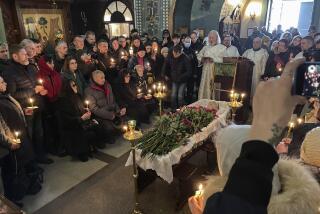Who’s Buried in Lenin’s Tomb? Soon It May Be No One
- Share via
MOSCOW — The queue snakes from the lower end of Moscow’s Red Square in a long, untidy loop, and, just as in Soviet times, people stop to ask what could be worth such a wait. Their faces contract in surprise at the answer: Lenin’s mausoleum.
After the 1991 collapse of the Soviet Union, the few Russians who still wanted to see V.I. Lenin’s preserved corpse could walk right in without a wait. Eight years on, can the queue really be back?
Since President Boris N. Yeltsin reignited speculation recently that Lenin would be buried and the mausoleum removed, Russians have been lining up, waiting for up to an hour to see the remains of the Bolshevik leader. The president said Lenin would certainly be buried, but he did not say when.
A year ago, polls showed that 55% to 60% of the population favored Lenin’s burial, with 30% opposed. But a poll this month by the Public Opinion Foundation found 41% in favor and 41% against.
The possibility that Lenin might suddenly disappear from Red Square--like the mausoleum’s goose-stepping honor guard, which was abruptly banished in October 1993--was not the main motive for those lining up one recent summer day. Many were regular visitors, others were showing friends and relatives around, some were provincial Russians who said they felt that no visit to the capital was complete without seeing Lenin, and there was a handful of foreign visitors.
For the foreigners, the mausoleum offers the complete Soviet experience--queue thrown in--with surly guards who search bags for cameras, guns and mobile phones. They run metal detectors over visitors, loudly shush anyone who makes a sound inside the mausoleum and blow whistles at any visitor who steps out of line outside it.
After the long wait, visitors enter the black marble mausoleum, eyes struggling to adjust to the darkness, and shuffle cautiously forward. In the inner sanctum an eerie light throws a fluorescent pinkish glow on the leader in his glass case, and the guards rush forward to hustle along anyone who stops for even a moment to gawk at the spots on Lenin’s tie.
To some, Lenin’s pallid features convey an unearthly aura. When Grigory Karpenko, 44, a stockbroker from Moscow, first visited Lenin’s tomb in his youth, “I saw what I expected--a mummified man. He didn’t seem real.” Now Karpenko is back, hosting relatives from out of town.
Igor Secretaryov, 28, a military officer from Astrakhan near the Caspian Sea, has always found the mausoleum inspiring, so this time he brought his wife along. “The first time I was here, I got a great feeling, as if I was part of history. The last time, three years ago, I still had a feeling of euphoria, of something mysterious and a connection to the past.”
Lyudmila Markilova, 59, flashing a mouth full of gold teeth, brought her grandchildren. “We should not bury our history. He has been here, he is here, and he will be here,” she said.
Yeltsin’s comments on Lenin’s burial set Moscow’s creaky rumor mill whirring, with conspiracy theorists convinced that Lenin’s removal would spark riots, giving the president a chance to declare a state of emergency and cancel upcoming elections. Yeltsin has since promised that there will be no state of emergency and that the elections will be held on time.
Whatever Yeltsin’s motive, his announcement certainly succeeded in provoking his Communist opponents, and nowhere more than in Ulyanovsk, Lenin’s hometown, where officials are agitated about the burial issue.
Some Lenin supporters in Ulyanovsk say it would be better to transfer the mausoleum to the city’s own Lenin Square than to have the Communist icon, who died in 1924, hoisted out of his display case and planted in the ground. After all, they argue, he was an atheist, so he hardly needs a Christian burial.
Ulyanovsk’s square is large enough to fit the mausoleum between a huge Lenin statue and the Lenin museum.
“If there’s no way out of the situation, and the leaders will not allow the mausoleum in Red Square, of course we’ll take it here. We’re ready for it. It’s an extreme measure, but we’re ready to do anything to prevent Lenin’s body from destruction,” said Vladimir V. Sverkalov, deputy director of the museum, which attracted 6,000 political pilgrims daily in the 1970s.
For Karpenko, standing in the Moscow queue, the long line of people is the strongest argument against the closure of the mausoleum. He thinks that it has plenty of potential as a commercial enterprise, if only someone with a bit of business acumen would take over and introduce an entry fee.
More to Read
Sign up for Essential California
The most important California stories and recommendations in your inbox every morning.
You may occasionally receive promotional content from the Los Angeles Times.













